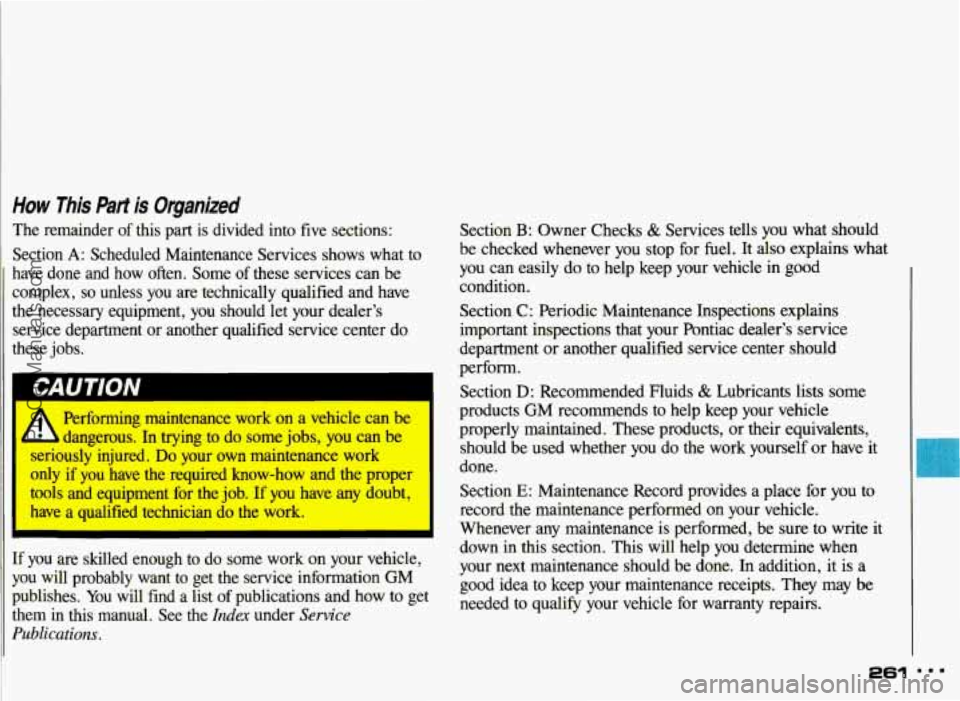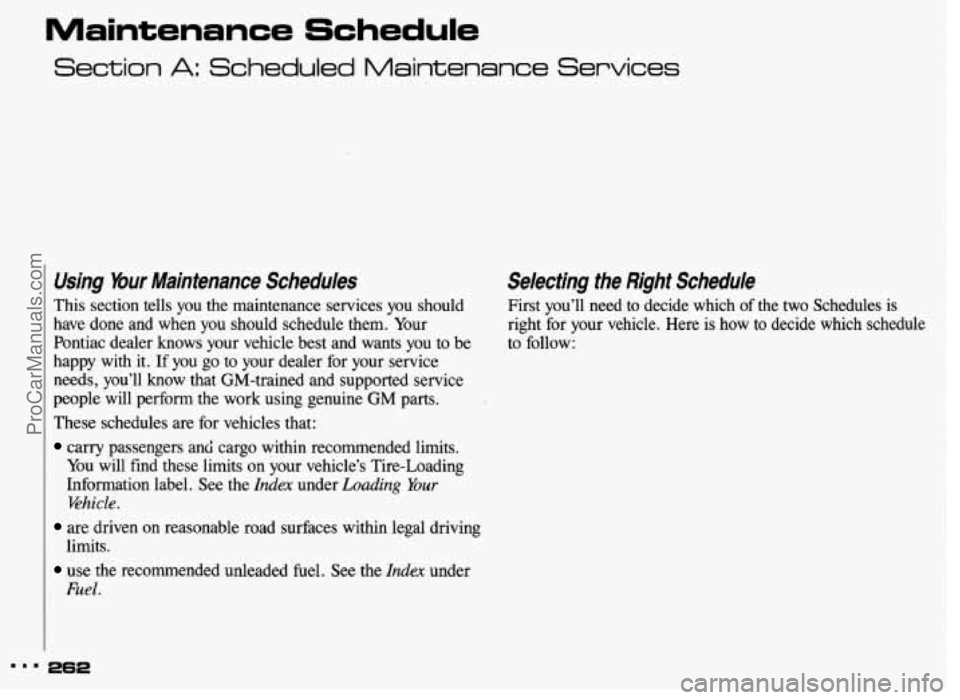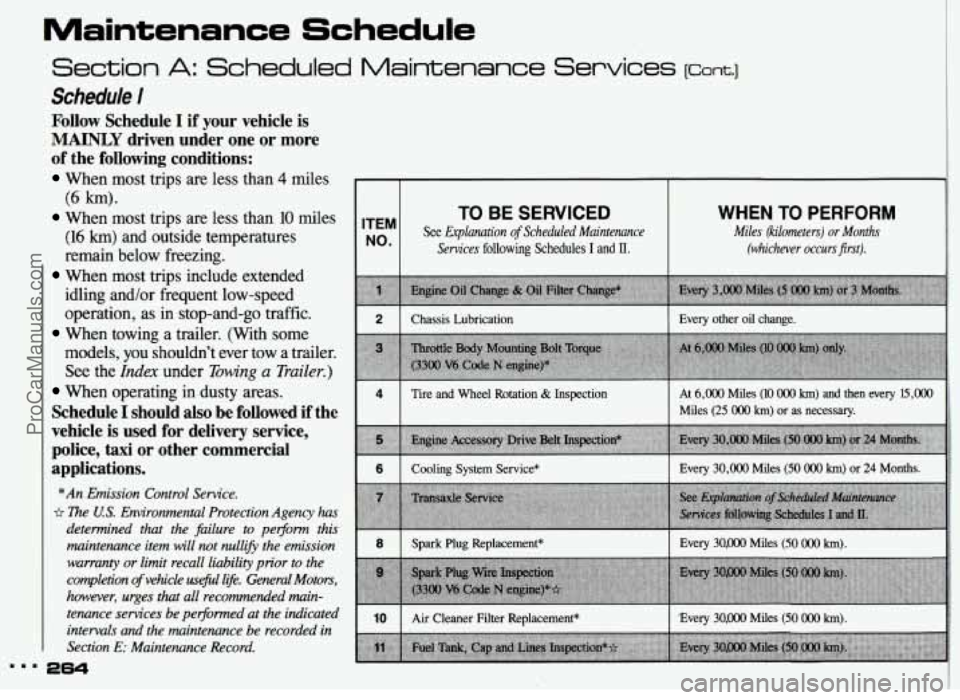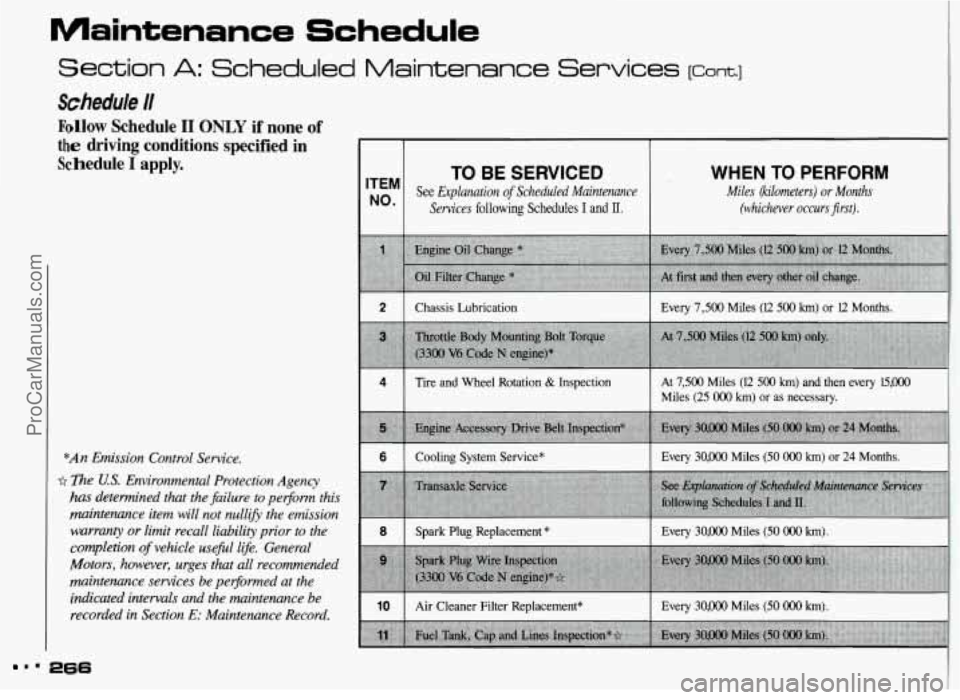1993 PONTIAC GRAND-AM maintenance
[x] Cancel search: maintenancePage 262 of 306

How This Part is Organized
The remainder of this part is divided into five sections:
Section
A: Scheduled Maintenance Services shows what to
have done and how often. Some of these services can be
complex,
so unless you are technically qualified and have
the necessary equipment, you should let your dealer's
service department or another qualified service center do
these jobs.
Performing maintenance work on a vehicle can be
3 dangerous. In trying to do some jobs, you can be
.-' wsly injured. Do your own maintenance work
UIUY if you have the required know-how and the proper
tools and equipment for the job. If
you have any doubt,
have a qualified technician do the work.
I
If you are skilled enough to do some work on your vehicle,
you will probably want to get the service information GM
publishes. You will find a list
of publications and how to get
them in this manual. See the
Index under Service
Publications.
Section B: Owner Checks & Services tells you what should
be checked whenever you stop for fuel. It
also explains what
you can easily do to help keep your vehicle in good
condition.
Section
C: Periodic Maintenance Inspections explains
important inspections that your Pontiac dealer's service
department or another qualified service center should
perform.
Section
D: Recommended Fluids & Lubricants lists some
products GM recommends to help keep your vehicle
properly maintained. These products, or their equivalents,
should be used whether you do the work yourself or have it
done.
Section
E: Maintenance Record provides a place for you to
record the maintenance performed on your vehicle.
Whenever any maintenance is performed, be sure to write it
down in this section. This will help you determine when
your next maintenance should be done. In addition, it is a
good idea to keep your maintenance receipts. They may
be
needed to qualify your vehicle for warranty repairs.
ProCarManuals.com
Page 263 of 306

Maintenance Schedule
Section A: Scheduled Maintenance Services
Using Your Maintenance Schedules
This section tells you the maintenance services you should
have done and when you should schedule them. Your
Pontiac dealer knows your vehicle best and wants you
to be
happy with it. If you go to your dealer for your service
needs, you’ll know that GM-trained and supported service
people will perform the work using genuine GM parts.
These schedules are for vehicles that:
carry passengers anti cargo within recommended limits.
You will find these limits
on your vehicle’s Tire-Loading
Information label. See the
Index under Loading Your
Elzicle.
limits.
Fuel.
are driven on reasonable road surfaces within legal driving
use the recommended unleaded fuel. See the Index under
Selecting the Right Schedule
First you’ll need to decide which of the two Schedules is
right for your vehicle. Here is how to decide which schedule
to follow:
ProCarManuals.com
Page 265 of 306

Maintenance Schedule
...
Section A: Scheduled Maintenance Services lcont.1
Schedule 1
Follow Schedule I if your vehicle is
MAINLY driven under one or more
of the following conditions:
When most trips are less than 4 miles
When most trips are less than 10 miles
(6 km).
(16 km) and outside temperatures
remain below freezing.
When most trips include extended idling and/or frequent low-speed
operation, as in stop-and-go traffic.
When towing a trailer. (With some
models,
you shouldn’t ever tow a trailer.
See the
Index under Towing a Trailer.)
When operating in dusty areas.
Schedule I should also be followed if the
vehicle is used for delivery service, police,
taxi or other commercial
applications.
*An Emission Control Sewice.
* Re US. Environmental Protection Agency has
determined that the failure to perform this
maintenance item
will not nullify the emission
warranty or limit recall liability prior to the
completion
of vehicle usejkl lije. General Motors,
however, urges that all recommended main- tenance services be performed at the indicated
intervals and the maintenance be recorded
in
Section E: Maintenance Record.
264
ITEM
NO.
2
4
6
8
10
TO BE SERVICED
See Explanation of Scheduled Maintenance
Services
following Schedules I and 0.
WHEN TO PERFORM
Miles (kilometers) or Months
(whichever occurs jrst).
ProCarManuals.com
Page 267 of 306

Maintenance Schedule
Section A: Scheduled Maintenance Services lcont.1
Schedule I1
Follow Schedule I1 ONLY if none of
the driving conditions specified in
Schedule
I apply.
*An Emission Control Sewice.
fi The US. Environmental Protection Agency
has determined that the failure to per$orm this
maintenance item
will not nullifL the emission
warranty or limit recall liability prior to the
completion
of vehicle usefil life. General
Motors, however, urges that
all recommended
maintenance services be per$ormed at the
indicated intervals and the maintenance be recorded in Section
E: Maintenance Record.
TO BE SERVICED
See &planation of Scheduled Maintenance
Services following Schedules I and II.
ITEM
No'
WHEN TO PERFORM
Miles (kilometers) or Months
(whichever occurs first).
2 I Chassis Lubrication 1 Every 7,500 Miles (E 500 km) or 12 Months.
Tire and Wheel Rotation
& Inspection At 7,500 Miles (12 500 km) and then every l5,000
Miles (25 000 km) or as necessary.
6 I Cooling System Service* I Every 30,000 Miles (50 000 km) or 24 Months.
8 I Spark Plug Replacement * I Every 30,000 Miles (50 000 km).
10 I Air Cleaner Filter Replacement* I Every 30,000 Miles (50 000 lan).
' 266
ProCarManuals.com
Page 269 of 306
![PONTIAC GRAND-AM 1993 Owners Manual Maintenance Schedule
Section A: Scheduled Maintenance Services [cant.]
Explanation of Scheduled Maintenance Services
Below are explanations of the services listed in Schedule I
and Sched PONTIAC GRAND-AM 1993 Owners Manual Maintenance Schedule
Section A: Scheduled Maintenance Services [cant.]
Explanation of Scheduled Maintenance Services
Below are explanations of the services listed in Schedule I
and Sched](/manual-img/50/58387/w960_58387-268.png)
Maintenance Schedule
Section A: Scheduled Maintenance Services [cant.]
Explanation of Scheduled Maintenance Services
Below are explanations of the services listed in Schedule I
and Schedule II.
The proper fluids and lubricants to use are listed in
Section D. Make sure whoever services your vehicle uses
ITEM
NO. SERVICE
1 Engine Oil and Filter Change-Always use SG
Energy Conserving 11 oils of proper viscosity.
The “SG” designation may be shown alone or
in
combination with others, such as “SG/CC,”
“SG/CD” or
“SF, SG, CC,” etc. If you have the
2.3L Quad OHC or a Quad
4 engine, the preferred
viscosity for your vehicle’s engine is
SAE 5W-30.
However, you can use
SAE 1OW-30 if it’s going to
be
0°F (-18°C) or above. If you have the 3300 V6
engine, the preferred viscosity for your vehicle’s
engine is
SAE 1OW-30. However, you can use SAE
5W-30 if it’s going to be 60°F (16°C) or below. these. All parts should be replaced and all necessary repairs
done before you or anyone else drives the vehicle.
NOTE: To determine your engine’s displacement and code,
see the
Index under Engine Identijication.
ITEM
NO.
2
3
4
SERVICE
Chassis Lubrication-Lubricate the transaxle shift
linkage, parking brake cable guides, underbody
contact points and linkage. Lubricate the front and
rear suspension, steering linkage and fuel filler
door and striker plunger.
Throttle
Body Mounting Bolt Torque (3300 V6
Code N engine)*-Check the torque of the
mounting bolts and/or nuts.
Tire and Wheel Rotation and Inspection-For
proper wear and maximum tire life, rotate your
tires following the instructions in this manual. See
the
Index under llres, Inspection & Rotation.
Check the tires for uneven wear or damage. If you
see irregular or premature wear, check the wheel
alignment. Check for damaged wheels
also.
* An Emission Control Service.
i? The US. Environmental Protection Agency has determined that the failure to pe@orm this maintenance item will not nullifL the emission warranty or
limit recall liability prior to the completion
of vehicle useful life. General Motors, however, urges that all recommended maintenance sem’ces be
peflormed at the indicated intervals and the maintenance be recorded in Section E: Maintenance Record.
268
ProCarManuals.com
Page 271 of 306
![PONTIAC GRAND-AM 1993 Owners Manual Maintenance Schedule
Section A: Scheduled Maintenance Services [cant.]
ITEM
NO. SERVICE
10 Air Cleaner Filter Replacement*-Replace every
30,000 miles (50 000 km) or more often under
dusty c PONTIAC GRAND-AM 1993 Owners Manual Maintenance Schedule
Section A: Scheduled Maintenance Services [cant.]
ITEM
NO. SERVICE
10 Air Cleaner Filter Replacement*-Replace every
30,000 miles (50 000 km) or more often under
dusty c](/manual-img/50/58387/w960_58387-270.png)
Maintenance Schedule
Section A: Scheduled Maintenance Services [cant.]
ITEM
NO. SERVICE
10 Air Cleaner Filter Replacement*-Replace every
30,000 miles (50 000 km) or more often under
dusty conditions. Ask your dealer for the proper
replacement intervals for your driving conditions.
ITEM
NO. SERVICE
11 Fuel Tank, Cap and Lines Inspection* b-
Inspect fuel tank, cap and lines (including fuel rails
and injection assembly) for damage or leaks.
Inspect fuel cap gasket for an even filler neck
imprint or any damage. Replace parts as needed.
Periodic replacement of the fuel filter is not
required.
*An Emission Control Service,
-& ne US. Environmental Protection Agency has determined that the failure to pe$orrn this maintenance item will not nullify the emission warranty or\
limit recall liability prior to the completion
of vehicle useful life. General Motors, however, urges that all re\
commended maintenance services be
perjiormed at the indicated intervals and the maintenance be recorded in Section E: Maintenance Record.
270
ProCarManuals.com
Page 273 of 306
![PONTIAC GRAND-AM 1993 Owners Manual Maintenance Schedule
Section 6: Owner Checks & Services [corn.]
At Least Once a %ar
CHECK
OR SERVICE WHAT TO DO
Key Lock Cylinders Lubricate the key lock cylinders with the lubricant sp PONTIAC GRAND-AM 1993 Owners Manual Maintenance Schedule
Section 6: Owner Checks & Services [corn.]
At Least Once a %ar
CHECK
OR SERVICE WHAT TO DO
Key Lock Cylinders Lubricate the key lock cylinders with the lubricant sp](/manual-img/50/58387/w960_58387-272.png)
Maintenance Schedule
Section 6: Owner Checks & Services [corn.]
At Least Once a %ar
CHECK
OR SERVICE WHAT TO DO
Key Lock Cylinders Lubricate the key lock cylinders with the lubricant specified in Section D.
Body Lubrication Lubricate all body door hinges. Also lubricate all hinges and latches, including those \
for the
hood, trunk, glove box door, console door, and any folding seat hardware. S\
ection
D tells you
I
t
what to use.
CAUTION I
When you are doing this check, the vehicle could move suddenly. If it does, you or others
a could be injured. Follow the steps below.
1. Before you start, be sure you have enough room around the vehicle.
2. Firmly apply both the parking brake (see the Ida under Parking Brake if necessary) and the
NOTE:
Do not use the accelerator pedal, and be ready to turn off the engine immediately if it
Starts.
3. On automatic transaxle vehicles, try to start the engine in ea\
ch gear. The starter should work
only
in P (Park) or N (Neutral). If the starter works in any other position, your vehicle needs
service.
On manual transaxle vehicles, put the
shift lever in N (Neutral), push the clutch down halfway
and try to start the engine. The starter should work only when the clutch is pushed down all
the way
to the floor. If the starter works when the clutch isn't pushed all the way down, your
vehicle needs service. regular brake.
ProCarManuals.com
Page 275 of 306
![PONTIAC GRAND-AM 1993 Owners Manual Maintenance Schedule
Section 6: Owner Checks & Services [cant.]
I At Least Once a bar (conr~.)
CHECK
OR SERVICE WHAT TO DO
rarmg Brae
and
Automatic Transaxle
P (Park) Mechanism
Check
I
PONTIAC GRAND-AM 1993 Owners Manual Maintenance Schedule
Section 6: Owner Checks & Services [cant.]
I At Least Once a bar (conr~.)
CHECK
OR SERVICE WHAT TO DO
rarmg Brae
and
Automatic Transaxle
P (Park) Mechanism
Check
I](/manual-img/50/58387/w960_58387-274.png)
Maintenance Schedule
Section 6: Owner Checks & Services [cant.]
I At Least Once a bar (conr~.)
CHECK
OR SERVICE WHAT TO DO
rarmg Brae
and
Automatic Transaxle
P (Park) Mechanism
Check
I
Underbody Flushing
m.. 274
When you are doing this check, your vehicle could begin to move. You or others could be
- b injured and property could be damaged. Make sure there is room in front of your vehicle
in case it begins to roll. Be ready to apply the regular brake at once should the vehicle begin to
move.
Park on a fairly steep hill, with the vehicle facing downhill. Keeping your foot on the regular
brake, set the parking brake.
To check the parking brake: With the engine running and the transaxle in N (Neutral), slowly
remove foot pressure from the regular brake pedal.
Do this until the vehicle is held by the
parking brake only.
To check the P (Park) mechanism’s holding ability: Shift to P (Park). Then release all brakes.
At least every spring, use plain water to flush
any corrosive materials from the underbody. Take
care to clean thoroughly any areas where mud
and other debris can collect.
ProCarManuals.com